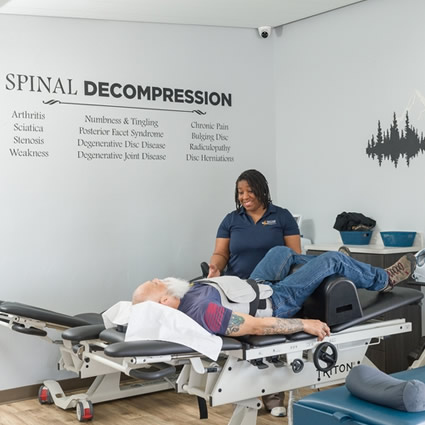Spinal Decompression in Plano and McKinney
 For people suffering with disc issues and other conditions affecting the neck or low back, spinal decompression therapy can often be an effective solution. Using state-of-the-art technology, we help restore health to the discs and relieve pressure on the joints to facilitate healing.
For people suffering with disc issues and other conditions affecting the neck or low back, spinal decompression therapy can often be an effective solution. Using state-of-the-art technology, we help restore health to the discs and relieve pressure on the joints to facilitate healing.
Who It Helps
Discs are the “shock absorbers” between your spinal vertebrae, and when they are damaged by injury, disease or even the effects of gravity, they can’t work as they’re supposed to. Since discs rely on motion to pump nutrients in and toxins out, when the disc or joint fails to move properly, the joint will begin to dry up and break down over time, and the resulting pressure on the nerves leads to chronic pain.
This therapy aims to relieve pressure on the joint, the disc, and the nerve to reduce pain and allow fluid to flow back inside the disc, bringing a normal supply of nutrients so the joint can heal.
The types of conditions that respond well to this therapy include:
- Arthritis
- Bulging discs
- Chronic pain
- Degenerative joint disease
- Disc herniations
- Numbness and tingling
- Posterior facet syndrome
- Radiculopathy
- Sciatica
- Stenosis
- Weakness
What to Expect
It typically takes between 12 and 24 sessions to achieve maximum results with this therapy.
Each decompression session is about 15 minutes, and you’ll lie comfortably on our computerized table that will repeatedly apply a gentle stretch and then release to relieve the pressure on your joints and discs. The therapy is not painful, and most patients find it very relaxing.
Frequently Asked Questions
Who Can Benefit from Spinal Decompression?
- Pinched/compressed nerve
- Bulging disc
- Herniated disc
- Slipped disc
- Arthritis
- Sciatica
- Pain and/or tingling down your arm or leg
- Spinal stenosis
- Facet joint syndrome
- Scoliosis
- Degenerative disc disease
- Degenerative joint disease
Is Spinal Decompression Painful?
How Long Does a Spinal Decompression Session Take?
How Many Spinal Decompression Sessions Are Needed?
Are There Any Side Effects of Spinal Decompression Therapy?
Is Spinal Decompression Covered by Insurance?
What Should I Expect During a Spinal Decompression Session?
Are There Any Contraindications for Spinal Decompression Therapy?
- Pregnancy: Manual adjustments may be a better option.
- Spinal fractures: Stretching the spine during spinal decompression may worsen this injury.
- Metal implants in the spine: Spinal decompression is not recommended for patients with spinal implants.
- Abdominal aortic aneurysm (AAA): This serious condition involves an enlarged blood vessel in the stomach region.
- Osteoporosis: Patients with weak bones should avoid non-surgical spinal decompression.
- Infection in the spinal disc space: This rare condition, known as discitis, may be worsened by non-surgical spinal decompression.
- Metastatic cancer: Patients with this condition should avoid spinal decompression therapy.
Get Started Today
We want to help you get out of chronic low back and neck pain—contact us to schedule your first appointment.
CONTACT US

